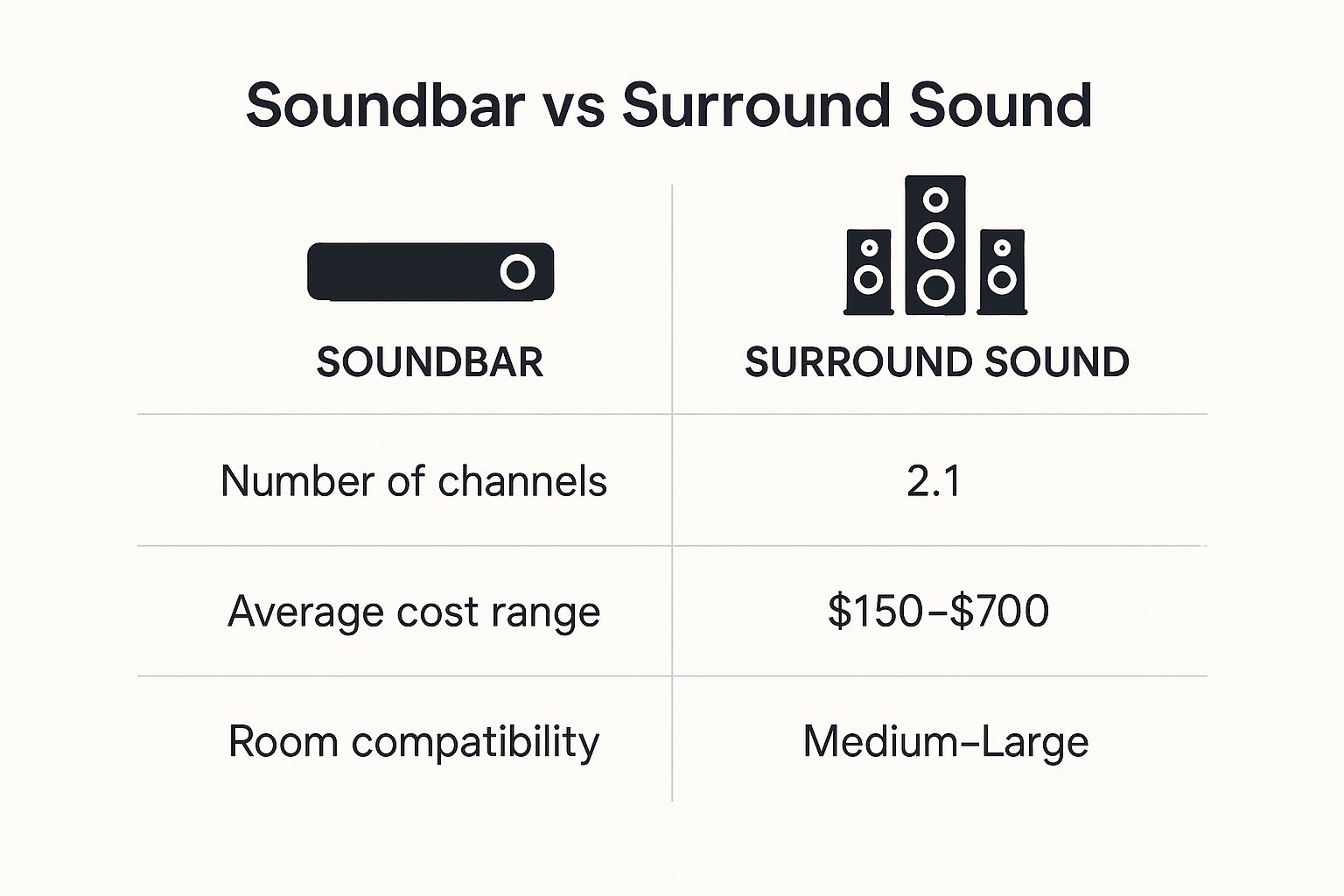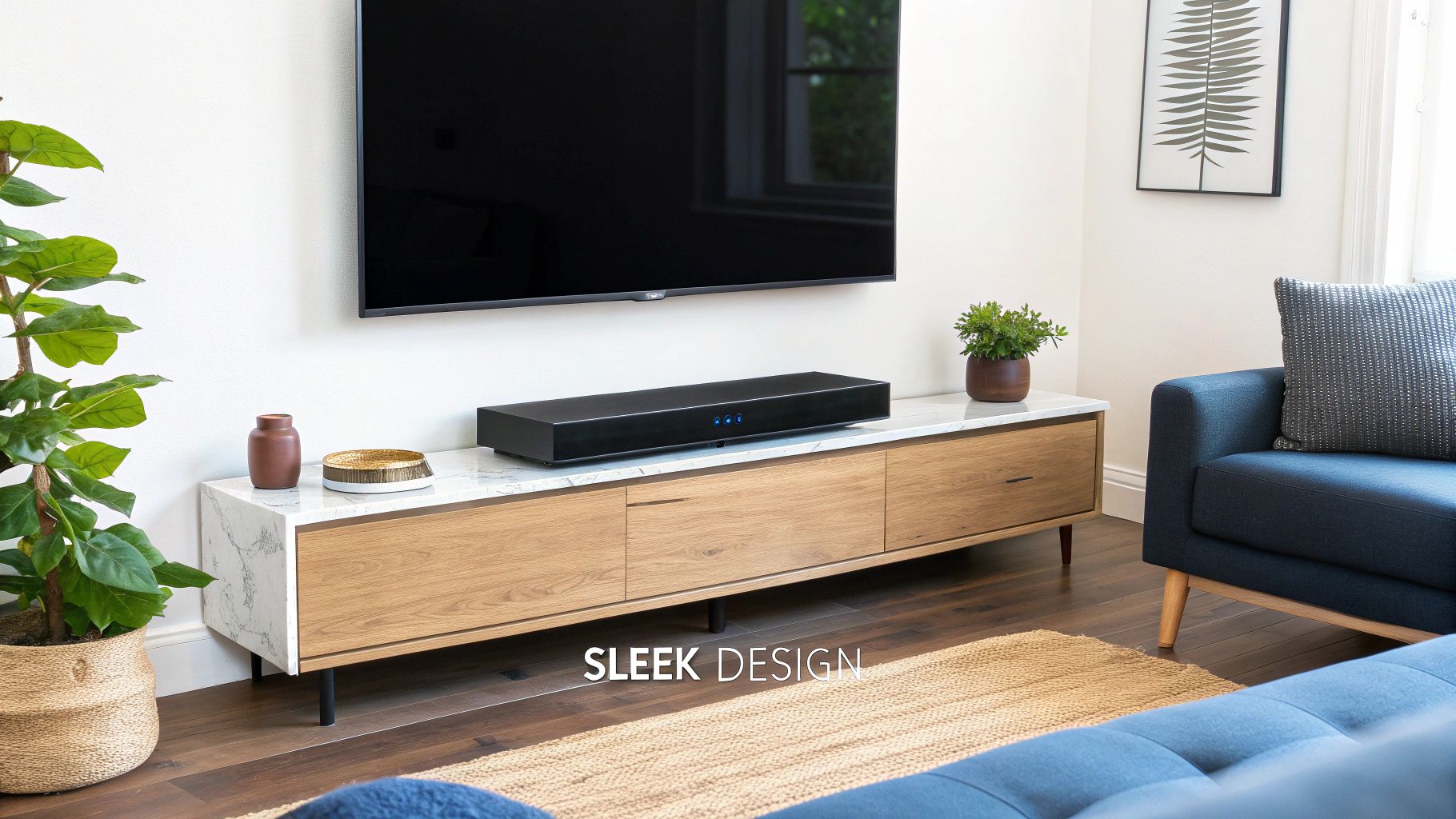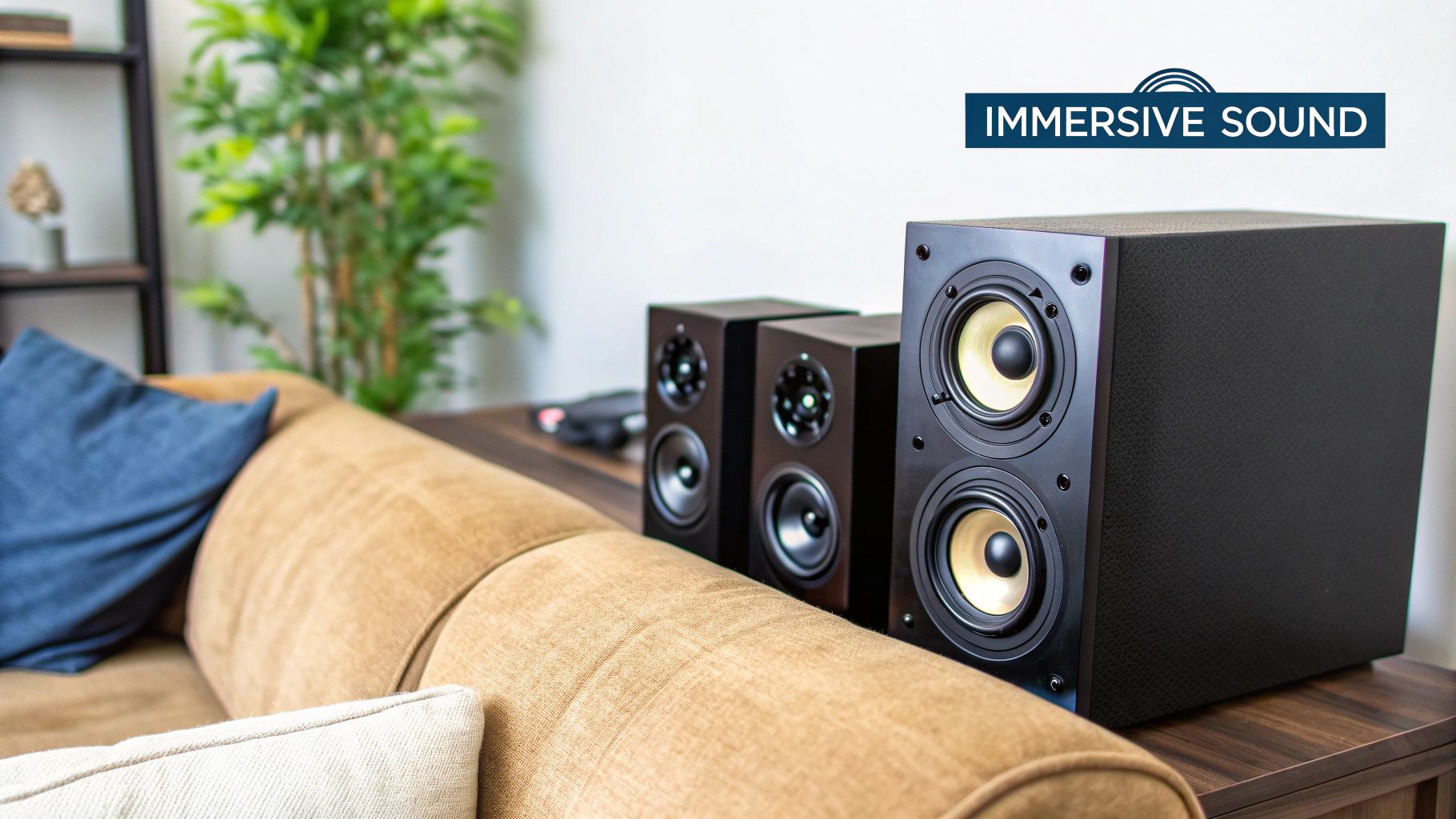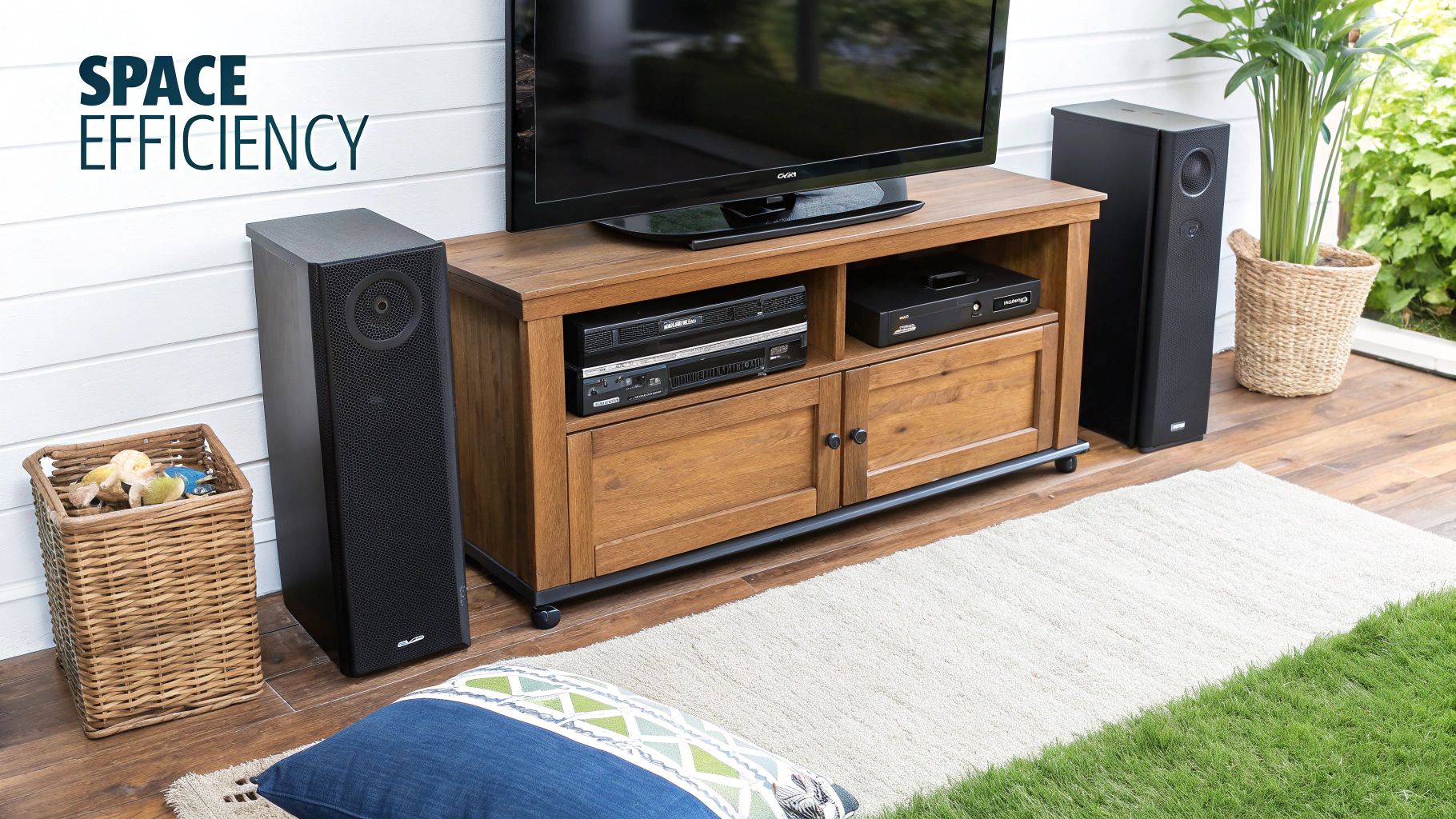The core difference really boils down to this: a soundbar is all about simplicity and convenience wrapped up in a single, clean package. On the other hand, a traditional surround sound system is built for one thing—true, uncompromised audio immersion using multiple, carefully placed speakers.
Your decision hinges on what you value more: a minimalist, plug-and-play setup or the most authentic, room-filling sound you can get. To help you choose, explore our full collection of audio and visual mounting solutions.
The Modern Home Audio Dilemma
Choosing the right audio system is one of the most important decisions you'll make for your home entertainment. It's the real difference between just watching a movie and feeling like you're dropped right into the middle of the action. The central debate pits the sleek, all-in-one soundbar against the powerful, multi-component surround sound system.
This isn't just a question of volume. We're talking about clarity, sonic depth, and the spatial accuracy that lets you pinpoint exactly where every sound is coming from. A quality audio setup means you'll catch every whispered line of dialogue, feel the deep rumble of an explosion, and track a starship as it flies overhead in a sci-fi epic. For anyone who takes their movies, gaming, or even music seriously, getting this choice right is crucial.
Key Differentiators at a Glance
The image below gives you a quick snapshot of the essential trade-offs, covering everything from cost and speaker channels to the ideal room size for each setup.

As you can see, soundbars generally come with a smaller price tag and are a natural fit for smaller rooms. Surround sound systems command a higher price but deliver superior channel separation that really shines in larger spaces.
The popularity of soundbars has absolutely skyrocketed as people look for a simple, effective upgrade from their TV's lackluster built-in speakers. In fact, the global soundbar market was valued at around $4.2 billion and is projected to nearly double to $8.0 billion by 2033. This boom really underscores the massive demand for audio solutions that are user-friendly, save space, and still offer a major leap in sound quality. You can find more details on these market trends in various industry reports.
At its heart, the decision is a classic tug-of-war: convenience versus performance. A soundbar is the "instant gratification" choice that dramatically improves your audio right out of the box. A surround sound system is a more involved, component-based project that rewards your effort with an unmatched, discrete audio experience.
To really put things into perspective, let's break down the core differences in a quick comparison table.
Quick Comparison Soundbar vs Traditional Surround Sound
This table gives you a high-level summary of the fundamental trade-offs between a soundbar and a multi-speaker surround sound system. It's a great way to quickly see where each one shines.
| Attribute | Soundbar | Traditional Surround Sound |
|---|---|---|
| Setup Complexity | Very Low (often one cable) | High (requires receiver, speaker placement, and wiring) |
| Space Required | Minimal (a single bar under the TV) | Significant (multiple speakers and a receiver) |
| Audio Immersion | Good (often uses virtual surround) | Excellent (true, discrete channels from all directions) |
| Aesthetic Impact | Clean and minimalist | Noticeable and can be intrusive without careful planning |
Ultimately, this table highlights the core compromise you're making. With a soundbar, you trade a bit of immersive performance for a setup that's incredibly simple and clean. With a surround sound system, you accept more complexity and a larger physical footprint to achieve the absolute best audio experience.
Decoding True Audio Immersion
The term "immersive sound" gets thrown around a lot, but what does it actually mean for your listening experience? True immersion isn't just about cranking up the volume. It's about creating a believable, three-dimensional soundscape where you can pinpoint the exact location of every sound in the room. The debate between a soundbar vs surround sound system is really a clash between two very different philosophies for achieving this goal.

A soundbar, especially one without separate rear speakers, has to rely on some pretty clever engineering to fool your brain. It pulls this off using two main tricks of the trade:
- Psychoacoustics: This is the art of manipulating sound waves so your ears perceive them as coming from different places, even when they all originate from that single bar in front of you.
- Beamforming: More advanced soundbars pack multiple angled drivers inside. They use these to literally bounce sound off the walls and ceiling, creating reflections that mimic surround effects.
These techniques can create a surprisingly wide and spacious soundstage from just one piece of hardware. But at the end of the day, they are simulating immersion, not generating it with distinct, physical sound sources.
The Discrete Channel Difference
A traditional surround sound system takes a much more direct, physical approach. A standard 5.1 setup is the classic example, giving you five individual speaker channels and one subwoofer. Each speaker has a very specific job to do:
- Front Left & Right: These are your workhorses, handling the main musical score, sound effects, and any action happening off-screen.
- Center Channel: This is arguably the most important speaker. It's dedicated almost entirely to dialogue, keeping voices locked to the screen and crystal clear.
- Surround Left & Right: These create the world around you. Think rustling leaves, distant sirens, or spaceships flying past your shoulder.
- Subwoofer (.1): This handles all the low-frequency effects (LFE)—the rumbles, explosions, and thumps that you feel as much as you hear.
This "discrete channel" method means that when a TIE fighter screams past you on the left, the sound is physically coming from a speaker in that exact spot. The audio isn't bouncing off a wall to trick your ears; it’s genuinely originating from behind you.
A high-end soundbar can make you feel like you're inside the action, but a true surround sound system lets you pinpoint exactly where every sound within that action is coming from. It's the difference between an impressive illusion and authentic audio reality.
Picture a scene where two characters are talking, but one is standing just off-screen to the right. A surround system places that character's voice precisely in the front-right speaker, creating a completely natural sense of space. A soundbar will do its best to replicate this, but the sound is still fundamentally coming from the center, which can't quite match that true directional realism.
Ultimately, the choice comes down to weighing the incredible convenience and simplicity of a soundbar against the unmatched fidelity of a multi-speaker system. For anyone looking to perfect their home theater, exploring a good collection of audio and visual mounting solutions can make all the difference in getting the placement just right.
The Evolution of High-Performance Soundbars
Today's soundbars have come a long way from being just a simple step up from tinny TV speakers. The modern high-performance soundbar is a serious piece of audio engineering, blurring the lines in the soundbar vs surround sound debate and carving out a compelling middle ground for listeners who want great audio without the clutter. These aren't just single speakers anymore; they're sophisticated audio systems packed into a surprisingly compact form.

The biggest game-changer has been the integration of Dolby Atmos and dedicated up-firing drivers. These are specialized speakers, angled to bounce sound off your ceiling, creating a genuine sense of height. It’s this technology that delivers those overhead effects—like a helicopter flying past or the sound of rain—that define a truly three-dimensional sound experience.
Beyond the Bar Itself
But the evolution doesn't stop with the main unit. Premium soundbars now serve as the core of an expandable ecosystem, letting you build out a more immersive setup over time. Here’s what makes this new hybrid approach so compelling:
- Powerful Wireless Subwoofers: These units connect to the soundbar without a single wire, delivering the deep, cinematic rumble that a slim bar just can't produce on its own. This takes the low-frequency workload off the soundbar, freeing it up to deliver crystal-clear dialogue and richer mid-range audio.
- Optional Rear Satellite Speakers: For anyone who wants to move beyond simulated surround sound, many systems now offer dedicated wireless rear speakers. Adding these creates a true surround sound field, with distinct audio channels coming from behind you for a massive boost in immersion.
This modular design is a huge advantage. You can start with just the soundbar and then add the subwoofer and rear speakers later as your budget and desire for immersion grow. It creates a flexible and approachable path to a high-quality home theater, minus the immediate commitment of a full component system.
The modern premium soundbar is no longer a simple "either/or" choice against a full surround sound system. It's now a legitimate hybrid solution, offering impressive, multi-channel immersion without the traditional headaches of complex wiring and setup.
Market Innovation and Performance
The big audio brands are in a fierce race to squeeze cinema-quality sound into these streamlined packages. The soundbar market is constantly buzzing with new product launches that incorporate advanced features, dramatically improving the surround experience you can get from a single unit.
Ultimately, these advancements mean that a high-end soundbar package can deliver a legitimate and deeply satisfying home theater experience for a huge number of people. To make sure you get the most out of any setup, check out our complete collection of audio and video mounting solutions for the perfect placement.
Comparing Setup and Aesthetic Impact
Let's move beyond pure audio performance for a moment. How a system actually fits into your living space—both in terms of setup and visual appeal—is a massive part of the soundbar vs surround sound decision. The entire experience, from unboxing to your daily routine, is completely different for each, and so is the impact they have on your room's look and feel.
A soundbar is the definition of plug-and-play. The whole point is to get you from a sealed box to better sound in under ten minutes. Seriously. It’s usually just one power cord and a single HDMI cable that plugs into your TV's ARC or eARC port. That's it.
This simplicity means you don't have to deal with a bulky AV receiver, complicated calibration menus, or the headache of running speaker wire all over your living room. The result is a clean, minimal setup that doesn't ask you to redecorate your entire space.
The Surround Sound Installation Project
Setting up a traditional surround sound system, on the other hand, is less of a quick task and more of a weekend project. It requires some real planning and a comfort level with the more technical side of home audio. You’re not just plugging something in; you’re building a system.
- AV Receiver Hub: The AV receiver is the command center. Every single speaker needs to be wired directly back to this central unit.
- Speaker Placement: Getting that immersive sound means each speaker—fronts, center, and surrounds—has to be placed in just the right spot for proper audio imaging.
- Wire Management: This is often the biggest hurdle. Hiding all that speaker wire can involve running it through walls, using conduit, or strategically placing rugs and furniture.
- System Calibration: Once everything is hooked up, you have to run a calibration process to balance the speaker levels and account for the distances in your specific room.
This kind of hands-on approach delivers incredible performance, but it’s a genuine commitment of time and effort. It effectively turns your room into a dedicated media zone, which might not be what you’re looking for in a multi-purpose living area.
A soundbar is an appliance you add to a room; a surround sound system is an installation that becomes part of the room's architecture. The choice reflects whether you prioritize seamless integration or are building a purpose-driven home theater.
Visual and Aesthetic Trade-Offs
When it comes to looks, the two paths couldn't be more different. A soundbar is designed to be heard but not necessarily seen. It usually tucks in neatly right below your TV, blending into the background. If you’re someone who values a clean, uncluttered living space, the soundbar is the obvious choice.
A full surround sound system makes a statement. With its multiple speakers and a visible receiver, it has a distinct, high-tech presence. Some people love that look—it screams "serious home theater." But for others, it can feel visually cluttered or clash with their home decor. While choosing high-quality components from a great home entertainment collection can certainly help, you can't deny the system is there. This makes the final decision a deeply personal one, weighing your audio ambitions against your home’s interior design.
Analyzing the True Cost of Your Sound System

When you’re weighing a soundbar vs surround sound system, the price tag you see on the box is only the first chapter of the story. To figure out what you’re really spending, you have to look at the total cost of ownership—everything it takes to get from the box to a fully functioning setup in your living room.
A soundbar keeps things simple. For the most part, the price is all-inclusive. You get the bar itself, a power cord, and usually an HDMI cable. It’s a one-and-done purchase.
Surround sound, on the other hand, is a different beast entirely. It’s a component-based system, meaning the costs add up with each piece you buy. You aren’t just getting speakers; you’re investing in an AV receiver, a subwoofer, spools of speaker wire, and potentially stands or mounts for every single speaker.
Cost and Feature Comparison by Tier
The real value depends heavily on how much you're willing to invest. To give you a clearer picture of what your money buys at each level, we've broken down the typical costs and features for both soundbars and full surround sound systems.
| Tier | Soundbar (Price & Features) | Surround Sound System (Price & Features) |
|---|---|---|
| Entry-Level | $150 - $400: Basic 2.1 or 3.1 channels. You'll get much better dialogue clarity than your TV speakers and often a small wireless subwoofer. | $500 - $1,200: A complete 5.1 "home-theater-in-a-box" (HTiB) or a basic component setup with an entry-level AV receiver and compact satellite speakers. |
| Mid-Range | $400 - $900: Adds features like Dolby Atmos (usually via up-firing drivers), a more powerful subwoofer, and noticeably better audio fidelity. | $1,200 - $3,000: A much better AV receiver with more power, larger bookshelf or floor-standing front speakers, and a more authoritative subwoofer. |
| High-End | $900+: Premium multi-channel systems (like 9.1.4) with advanced room correction software, optional rear speakers, and high-quality drivers. | $3,000+: Fully component-based systems. Think high-end receivers or even separate processors and amps, premium brand speakers, and multiple powerful subwoofers for ultimate performance. |
This breakdown shows that as you climb the price ladder with a soundbar, you're paying for more advanced features and better virtual surround processing. And if you want to make sure your soundbar is perfectly placed without cluttering your media console, our collection of soundbar mounts can help you achieve a clean, professional look.
The real financial fork-in-the-road is modularity. A surround sound system lets you upgrade individual pieces over time—a new receiver this year, better front speakers next year. A soundbar is a self-contained unit that prioritizes plug-and-play simplicity over long-term flexibility.
Ultimately, your budget sets the boundaries. But the choice comes down to what you value more: immediate, hassle-free audio improvement, or a long-term investment in a system you can build and customize for years to come.
Which System Is Right for You?
So, how do you make the final call in the soundbar versus surround sound debate? It really boils down to an honest look at your space, your lifestyle, and what you truly want out of your audio experience. It's less about which system is technically "better" and more about which one is the right fit for you. Matching your real-world needs with the right gear is the secret to a setup you'll love for years.
Think about how you'll actually use it. If you're in a smaller space like an apartment, love a clean, minimalist look, or just want a massive audio upgrade without the fuss, a soundbar is your ideal choice. It delivers a night-and-day improvement over tinny TV speakers, all in a simple, elegant package.
Finding the Perfect Fit
On the other hand, for dedicated home theater buffs, a full surround sound system is the undisputed champion. If you have a larger room, crave the most authentic and powerful sound fidelity possible, and actually enjoy the process of building and tweaking a high-performance system, nothing else comes close. It’s the ultimate investment for pure, uncompromised immersion.
The best audio system is the one that seamlessly integrates into your life. For many, the perfect solution isn’t at the extremes but somewhere in the middle—a powerful hybrid system that balances convenience with immersive performance.
One of the most popular middle-ground options is the surround soundbar. These advanced units often come with a wireless subwoofer and even rear satellite speakers, aiming to replicate a true surround experience without all the wires. It's no surprise this market is booming; it's projected to more than double from $7.2 billion to roughly $14.3 billion by 2032. As you can see from these surround soundbar market insights, their growth is fueled by people who want incredible sound without needing a degree in audio engineering.
To see how different systems can integrate with your television setup, feel free to browse our complete collection of top-rated TV mounts and home audio solutions.
Frequently Asked Questions
When you're this close to a decision, it often comes down to a few final, practical questions. Let's clear up some of the most common points of confusion in the soundbar vs. surround sound debate.
Can a High-End Soundbar Truly Replace a 5.1 System?
While today’s premium soundbars, especially those with Dolby Atmos, can create a surprisingly wide and tall soundstage, they do it by simulating surround sound. It’s a clever trick, using advanced audio processing and angled drivers to bounce sound off your walls and ceiling to create an immersive bubble.
But can it truly replace the real thing? Not quite. A high-end soundbar can’t fully replicate the pinpoint-accurate, discrete audio that comes from having dedicated speakers physically placed behind you in a true 5.1 system. It boils down to a classic trade-off: the incredible convenience of a single bar versus the undeniable audio precision of separate speakers.
Do I Need an AV Receiver with a Soundbar?
Nope. In almost all cases, you won't need an AV receiver with a soundbar. The vast majority of soundbars are active, self-powered systems. They're designed to plug directly into your TV, usually with a single HDMI ARC/eARC cable.
This is one of the biggest wins for Team Soundbar. It completely sidesteps the need for a separate, often bulky AV receiver, which is the mandatory nerve center for any traditional, passive surround sound system. The result is a much cleaner and simpler setup from start to finish.
Upgradability is a key differentiator between these two audio paths. A component-based surround sound system is built for long-term evolution, allowing you to swap out individual parts as technology improves or your budget allows. A soundbar system prioritizes a cohesive, all-in-one experience right out of the box.
How Difficult Is It to Upgrade a Soundbar System?
With soundbars, your upgrade path is pretty limited. Many brands now offer their own ecosystem, letting you add a specific wireless subwoofer or a pair of matching rear speakers to your soundbar after the initial purchase. This definitely creates a more immersive, hybrid system.
However, that flexibility doesn't hold a candle to a component-based surround sound setup. With a traditional system, you have total freedom to upgrade your receiver, speakers, or subwoofer individually, mixing and matching brands whenever you want. If you have more questions about specific setups or need troubleshooting help, you can find answers to common inquiries on our comprehensive FAQ page.
Ready to perfect your home audio setup? From sleek soundbar mounts to sturdy speaker stands, Mount-It offers the smart, simple solutions you need to create the ultimate entertainment space. Explore our complete collection at https://www.mount-it.com.
